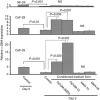Upregulation of cancer-associated myofibroblasts by TGF-β from scirrhous gastric carcinoma cells
- PMID: 21863023
- PMCID: PMC3185946
- DOI: 10.1038/bjc.2011.330
Upregulation of cancer-associated myofibroblasts by TGF-β from scirrhous gastric carcinoma cells
Abstract
Background: Myofibroblasts in the cancer microenvironment have recently been implicated in tumour growth and metastasis of gastric cancer. However, the mechanisms responsible for the regulation of myofibroblasts in cancer-associated fibroblasts (CAFs) remain unclear. This study was performed to clarify the mechanisms for regulation of myofibroblasts in gastric cancer microenvironment.
Methods: Two CAFs (CaF-29 and CaF-33) from the tumoural gastric wall and a normal fibroblast (NF-29) from the nontumoural gastric wall, 4 human gastric cancer cell lines from scirrhous gastric cancer (OCUM-2MD3 and OCUM-12), and non-scirrhous gastric cancer (MKN-45 and MKN-74) were used. Immunofluorescence microscopy by triple-immunofluorescence labelling (α-SMA, vimentin, and DAPI) was performed to determine the presence of α-SMA-positive myofibroblasts. Real-time RT-PCR was performed to examine α-SMA mRNA expression.
Results: Immunofluorescence microscopy showed that the frequency of myofibroblasts in CaF-29 was greater than that in NF-29. The number of myofibroblasts in gastric fibroblasts gradually decreased with serial passages. Transforming growth factor-β (TGF-β) significantly increased the α-SMA expression level of CAFs. Conditioned medium from OCUM-2MD3 or OCUM-12 cells upregulated the α-SMA expression level of CAFs, but that from MKN-45 or MKN-74 cells did not. The α-SMA upregulation effect of conditioned medium from OCUM-2MD3 or OCUM-12 cells was significantly decreased by an anti-TGF-β antibody or Smad2 siRNA.
Conclusion: Transforming growth factor-β from scirrhous gastric carcinoma cells upregulates the number of myofibroblasts in CAFs.
Conflict of interest statement
The authors declare no conflict of interest.
Figures




Similar articles
-
Cancer-associated fibroblasts might sustain the stemness of scirrhous gastric cancer cells via transforming growth factor-β signaling.Int J Cancer. 2014 Apr 15;134(8):1785-95. doi: 10.1002/ijc.28520. Epub 2013 Oct 24. Int J Cancer. 2014. PMID: 24155219
-
Epigenetic modulation and repression of miR-200b by cancer-associated fibroblasts contribute to cancer invasion and peritoneal dissemination in gastric cancer.Carcinogenesis. 2015 Jan;36(1):133-41. doi: 10.1093/carcin/bgu232. Epub 2014 Nov 19. Carcinogenesis. 2015. PMID: 25411357
-
Cancer-associated orthotopic myofibroblasts stimulates the motility of gastric carcinoma cells.Cancer Sci. 2012 Apr;103(4):797-805. doi: 10.1111/j.1349-7006.2012.02209.x. Epub 2012 Feb 15. Cancer Sci. 2012. PMID: 22320235 Free PMC article.
-
[Pathogenesis and progression of scirrhous carcinoma].Gan To Kagaku Ryoho. 1994 Oct;21(14):2364-70. Gan To Kagaku Ryoho. 1994. PMID: 7944478 Review. Japanese.
-
Crosstalk of tumor stromal cells orchestrates invasion and spreading of gastric cancer.Pathol Int. 2022 Apr;72(4):219-233. doi: 10.1111/pin.13211. Epub 2022 Feb 3. Pathol Int. 2022. PMID: 35112770 Review.
Cited by
-
Advances in the functions of CTRP6 in the development and progression of the malignancy.Front Genet. 2022 Oct 12;13:985077. doi: 10.3389/fgene.2022.985077. eCollection 2022. Front Genet. 2022. PMID: 36313428 Free PMC article. Review.
-
Cancer-Associated Fibroblast-Induced Resistance to Chemotherapy and Radiotherapy in Gastrointestinal Cancers.Cancers (Basel). 2021 Mar 9;13(5):1172. doi: 10.3390/cancers13051172. Cancers (Basel). 2021. PMID: 33803229 Free PMC article. Review.
-
Identification of extracellular matrix proteins secreted by human dermal fibroblasts cultured in 3D electrospun scaffolds.Sci Rep. 2021 Mar 23;11(1):6655. doi: 10.1038/s41598-021-85742-0. Sci Rep. 2021. PMID: 33758206 Free PMC article.
-
Multidisciplinary therapy for scirrhous gastric cancer: a retrospective analysis and proposal of new treatment strategy.Cancer Manag Res. 2018 Sep 24;10:3833-3839. doi: 10.2147/CMAR.S174950. eCollection 2018. Cancer Manag Res. 2018. PMID: 30288114 Free PMC article.
-
Transforming growth factor-β1 and α-smooth muscle actin in stromal fibroblasts are associated with a poor prognosis in patients with clinical stage I-IIIA nonsmall cell lung cancer after curative resection.Tumour Biol. 2014 Jul;35(7):6707-13. doi: 10.1007/s13277-014-1908-y. Epub 2014 Apr 9. Tumour Biol. 2014. PMID: 24711139
References
-
- Casey TM, Eneman J, Crocker A, White J, Tessitore J, Stanley M, Harlow S, Bunn JY, Weaver D, Muss H, Plaut K (2008) Cancer associated fibroblasts stimulated by transforming growth factor beta1 (TGF-beta 1) increase invasion rate of tumor cells: a population study. Breast Cancer Res Treat 110: 39–49 - PubMed
-
- De Wever O, Demetter P, Mareel M, Bracke M (2008) Stromal myofibroblasts are drivers of invasive cancer growth. Int J Cancer 123: 2229–2238 - PubMed
-
- De Wever O, Nguyen QD, Van Hoorde L, Bracke M, Bruyneel E, Gespach C, Mareel M (2004) Tenascin-C and SF/HGF produced by myofibroblasts in vitro provide convergent pro-invasive signals to human colon cancer cells through RhoA and Rac. FASEB J 18: 1016–1018 - PubMed
-
- Desmouliere A, Guyot C, Gabbiani G (2004) The stroma reaction myofibroblast: a key player in the control of tumor cell behavior. Int J Dev Biol 48: 509–517 - PubMed
Publication types
MeSH terms
Substances
LinkOut - more resources
Full Text Sources
Medical

